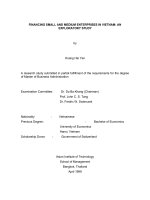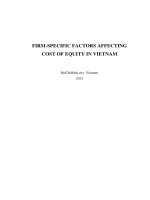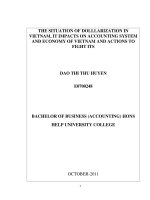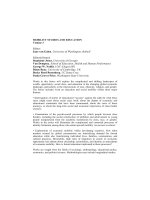Several issues of stratification in the working class in Vietnam today
Bạn đang xem bản rút gọn của tài liệu. Xem và tải ngay bản đầy đủ của tài liệu tại đây (1.12 MB, 4 trang )
CHIẾN LƯỢC VÀ CHÍNH SÁCH DÂN TỘC
SEVERAL ISSUES OF STRATIFICATION IN THE WORKING CLASS
IN VIETNAM TODAY
Tran Van Giang
University of Economics & Business
Administration, Thai Nguyen University
Email:
Received: 15/10/2019
Reviewed: 25/10/2019
Revised: 30/10/2019
Accepted: 9/11/2019
Released: 20/11/2019
DOI:
S
ocial stratification is the division of society into different
strata of economic, political, cultural and social status.
In a class society, within each class there is also stratification.
Vietnamese working class right from its inception until now,
that stratification has been and is still taking place, due to the
impact of domestic socio-economic development and external
influences. The paper analyzes the stratified status of the working
class, thereby proposing some solutions to develop Vietnam’s
working class, the current period.
Keywords: Social stratification; Vietnamese working class;
Solutions for developing working class.
1. Introduction
The process of industrialization, modernization
and international integration has been strongly
affecting the working class of Vietnam in many
aspects: quantity, quality, structure, political
consciousness, discipline and working ethics. In
particular, the working class of Vietnam has also been
deeply stratified, so it is very important to explore
this issue seriously to fully realize the positive and
limitations of that stratification, thus having practical
solutions to develop the working class.
2. Study overview
Vietnamese working class is the subject with
many related articles and researches. Typical works
are: “Vietnamese working class in the process
of national industrialization and modernization”
(Ngoc, 2004); “Contributing to building the
working class of Vietnam, from the situation of
working class in Ho Chi Minh City” (Thanh,
2008); “Current Vietnamese working class and
trade unions - challenges and prospects” (Tho,
2017); “Vietnamese working class with knowledge
economy” (Tao, 2007)... These works have shown
that compared to the period before Renovation,
Vietnamese working class has a lot of fluctuations
with the emergence of new types of workers, along
with that the stratification within the working class
is increasingly deep. The authors also forecast that
in the coming time, the structure and stratification
of the working class in Vietnam will continue to
deepen. Inheriting the research results achieved,
with specific data from the “Statistical Yearbook”,
we continue to clarify the confirmed issues, further
analyze the stratification situation in the working
class, propose solutions to develop the Vietnamese
24
working class in the current period.
3. Research method
The paper uses the methodology of Marxist Leninist philosophy (the development principle of
dialectical materialism; the theory of the law of
production relations in accordance with the level of
development of the production force) so that clarify
the emergence and movement of stratification in the
working class, explain the causes of stratification
in the working class in Vietnam. The research uses
analysis, comparison and modeling methods to
analyze stratification status in the working class
of Vietnam. In addition, the research also uses an
approach of dividing the working class according
to criteria of economic sectors, industries, and
qualifications to analyze the stratification of the
working class according to these criteria.
4. Research results
4.1. Stratification in the working class
Social stratification is the division of society into
different strata of economic, political, cultural and
social status. When private ownership was born, the
society was divided into classes. The classes differ in
status in the social production system, from which
there arise many other differences between classes. In
a class society, there are not only differences between
classes, but also in each class, there are differences
among people in terms of economy, politics,
social prestige,... Stratification. in the class, there
are two forms: regular stratification and irregular
stratification. The first form naturally formed due to
the difference in talent, intelligence, it plays a role
in promoting social development. The second form
is based on unethical factors and illegal acts, which
JOURNAL OF ETHNIC MINORITIES RESEARCH
CHIẾN LƯỢC VÀ CHÍNH SÁCH DÂN TỘC
inhibit social development. The root of stratification
in each class is due to the difference in individual
capacities and division of labor. Stratification in class
is an indispensable objective phenomenon in the
development process of each class.
4.2. The situation of stratification in the
working class of Vietnam today
“The working class of Vietnam is a huge,
growing social force, comprising manual and
manual workers, salaried workers, in various types
of production, business and industrial services.
or production, business and service of industrial
nature” (Central Propaganda Department, 2008,
p.13). The working class in Vietnam bears the
essence of the working class in general and has
all the characteristics of the international working
class. The working class in Vietnam differs from
the working class in other countries in the “national
character” in many ways. Over the past years,
under the impact of socio-economic innovation, the
socialist-oriented market economy, the process of
integration and globalization, the modern industrial
revolution, the stratification of Vietnamese working
class has many changes compared to previous
periods. The stratification in the working class in
Vietnam takes place on all aspects of social life.
* Income stratification:
In Vietnam, there is a division of income
between workers of all economic sectors, workers
of industries, between intellectual workers and
traditional workers.
The income of workers in all types of businesses
increased from 2009 to 2016, but increased
unevenly. There is a big disparity in the income of
workers between types of businesses. In particular,
state-owned enterprises have the highest income,
then come to foreign-invested enterprises and nonstate enterprises with lower incomes. (See chart 1).
Unit: Thousand dong
Chart 1: Average monthly income of workers by type
Source: Statistical Yearbook 2014 and 2017
On the other hand, the income disparity between
workers in the same type of enterprise is also
increasing. Although workers may have shares,
but in general the majority of shares, stocks are
concentrated in the hands of some people with
money such as business managers. In enterprises
Volume 8, Issue 4
with foreign direct investment, many businesses
have the difference between the salary of workers
directly engaged in production and the salaries of
managers and business leaders up to 14-15 times
(Thanh, 2008, p.48)
Regarding the stratification of workers among
industries, chart 2 shows that the income of workers
from 2010 to 2016 has increased differently across
industries. In which the construction industry
increased the fastest. We also easily recognize the
difference in income of workers in all industries.
Finance, banking, insurance workers have the
highest income. The lowest is agriculture, forestry
and fisheries.
Unit: Thousand dong
Chart 2: Average monthly income of workers by
occupation
Source: Statistical Yearbook 2014 and 2017
Income stratification in the working class are
also reflected in the relationship between highlyskilled workers and low-skilled workers. Foreigninvested economic sector clearly shows this point.
Here, workers’ income is directly proportional to
their education and technical expertise. People with
high technical qualifications earn more than 3 times
more than unskilled workers (Thanh, 2008, p.48)
* The stratification of qualifications:
The qualification of workers is one of the
important indicators showing the quality of the
working class. The qualification of the working class
includes education and professional qualification,
and occupational skills. The qualification of the
working class in Vietnam has a clear division
between workers of different economic sectors,
economic sectors, and professions.
On education level. In almost of production and
business sectors, workers have low education. The
percentage of workers graduating from high school
is in the service and commerce sector, accounting
for the highest rate of 84.6%; This figure in forestry,
agriculture and fisheries is nearly 50%. In 2013,
3.1% of workers had primary education, 26.8% of
workers had lower secondary education, 70.1% of
workers had secondary education (Tho, 2017, p.31)
(See chart 3)
25
CHIẾN LƯỢC VÀ CHÍNH SÁCH DÂN TỘC
Unit: %
Chart 3: Training level of workers
On professional qualifications and occupational
skills. The proportion of untrained workers accounts
for 8.5%, workers trained in enterprises account for
48%, college degrees account for 6.6%, university
degrees make up 17.4%. More than 50% of young
workers have no vocational training. Trained
workers in the service and trade sectors with
professional training had the highest rate of 50.7%.
Meanwhile, this figure in the construction industry,
transportation is 50.7%; electronics and mechanical
engineering is 40.9%; Leather shoes industry is the
lowest with 20.4%.
In our country, a group of intellectual workers is
formed with high levels of education, expertise and
skills in high-tech and spearhead economic sectors.
For example, at the Vietnam Oil and Gas Group, the
university or college graduation rate is more than
40%. This figure in Vietnam Electricity Group is
nearly 30%, VietinBank, Vietcombank is more than
90% (Central Propaganda Department, 2008, p.9)
The qualification stratification leads to the
stratification of income and living standards.
Highly skilled workers are allowed to work in good
environments, with high incomes and a more stable
life; Low-skilled workers must work in a hazardous,
low-income environment.
From the above stratification, Vietnamese
working class can be divided into three classes:
firstly, intellectual workers with high levels of
education and specialization operating in modern
industries and services; secondly, unskilled workers,
simple labor, with low income, difficult life; thirdly,
middle-class workers are trained through vocational
schools, with a more stable life.
4.3. The cause of stratification in Vietnamese
working class today
The stratification in the working class of
Vietnam is, after all, an expression of the current
socio-economic changes in our country. A number
of causes can be listed as follows;
Firstly, the existence of many forms of
ownership and many economic sectors leads to the
formation of corresponding working classes. With
the appearance and transformation of ownership
towards the socialization of production means,
workers may have shares, which leads to different
26
economic status. There are parts with no or few
shares. The department with more shares has higher
incomes, they receive a portion of their surplus
value in the form of dividends.
Secondly, the dark side of the market economy
produces a selfish, self-serving and pragmatic
lifestyle that exaggerates the value of money,
disregards morality and conscience, leading to a part
of workers who are not interested in political issue.
Thirdly, the development and application of the
achievements of the modern scientific revolution
lead to the generation of new professions,
including high-tech engineering industries, from
which to form the knowledge economy and
the ministry. intellectual worker division. The
knowledge economy also pushes many people into
unemployment because they do not meet the job
requirements. The structure of economic industries
changes, the role of traditional industries decreases,
so traditional workers also have a declining share
and modern workers who are the product of
scientific revolutions will increase.
Fourthly, due to the trend of globalization and
regionalization, the formation of foreign-invested
enterprises has increased rapidly. Workers have access
to new scientific knowledge, techniques, technologies,
qualifications and income of a part of the workers.
In addition, the stratification in the working
class of Vietnam is also due to subjective reasons
such as positive effects in the Party and State’s
working-class development policies and policies
towards the development of numbers and quality,
qualifications, culture, political enlightenment. A
part of the workers is still afraid to study to improve
their qualifications, be slow to innovate, absorb
scientific achievements, be passive in getting jobs
and mentally afraid to change careers.
4.4. A number of solutions to develop
Vietnamese working class today
To develop the working class in both quantity
and quality; improving political skills, education,
professional skills, occupational skills, labor
discipline of workers, to limit the negative aspects
of stratification in the working class need to
implement these following basic solutions:
Firstly,
promoting
industrialization,
modernization and international integration
associated with the development of the knowledgeoriented economic economy. First of all, priority
should be given to the development of laborintensive industries to create jobs, promoting the
national competitive advantage of labor resources,
contributing to rapid labor restructuring. This is a
prerequisite for the use of labor resources, including
the working class at all levels, rational distribution of
labor among regions, sectors and economic sectors.
Secondly, developing economic, improving
JOURNAL OF ETHNIC MINORITIES RESEARCH
CHIẾN LƯỢC VÀ CHÍNH SÁCH DÂN TỘC
labor productivity and business efficiency of the
state economic sector in order to create conditions
for the working class in this economic sector to
become the nucleus of the working class, promoting
its core role.
Thirdly, improve the educational level,
professional skills and career skills by improving
the quality of teaching - learning, directly in
universities, colleges, vocational schools; continue
to promote vocational education for high school
students. For the working workers, they need
regular education so that they are aware of the
importance of raising qualifications. Vocational
training programs should be built on the basis of
actual production and business in enterprises,
localities, throughout the country and around
the world. Promote vocational training with the
identification, fostering and employment of skilled
and high-tech workers.
Fourthly, it is necessary to strengthen national
spiritual education, enlightenment awareness, and
References
Central Propaganda Department. (2008).
Research materials of Resolution of the
Sixth Central Conference, Socialist Course.
Hanoi: National Political Publishing House.
Ngoc, D. X. (2004). Vietnamese working class
in the process of national industrialization
and modernization. Hanoi: National Political
Publishing House.
Tao, V. (2007). Vietnamese working class with
knowledge economy. Hanoi: The Publishing
House of Political Theory.
improve the political spirit of the working class. In
the context of information technology revolution,
social network development, it is necessary to find
attractive and new forms of education. Utilizing
new means to educate national awareness and
political consciousness for the working class
creatively and effectively.
5. Conclusion
In the working class of Vietnam, stratification
has been taking place strongly by objective
and subjective reasons. This stratification is a
historical indispensable, therefore, it is necessary
to study and give practical solutions to promote
the positive effects, limiting the negative effects of
stratification. These are solutions: perfecting the
wage policy, developing a socialist-oriented market
economy, promoting the core role of the working
class in the state economic sector, improving the
education level. mentoring, professional, mental,
and political enlightenment consciousness of the
working class of Vietnam.
Thanh, N. D. (2008). Contributing to building
the working class of Vietnam, from the
situation of working class in Ho Chi Minh
City. Hanoi: National Political Publishing
House.
Tho, V. Q. (2017). Current Vietnamese working
class and trade unions - challenges and
prospects (ed). Labor Publishing House.
MỘT SỐ VẤN ĐỀ VỀ SỰ PHÂN TẦNG
TRONG GIAI CẤP CÔNG NHÂN Ở VIỆT NAM HIỆN NAY
Trần Văn Giang
Trường Đại học Kinh tế và Quản trị kinh
doanh, Đại học Thái Nguyên
Email:
Ngày nhận bài: 15/10/2019
Ngày gửi phản biện: 25/10/2019
Ngày tác giả sửa: 30/10/2019
Ngày duyệt đăng: 9/11/2019
Ngày phát hành: 20/11/2019
DOI:
Volume 8, Issue 4
Tóm tắt
Phân tầng xã hội là sự phân chia xã hội thành những tầng bậc
khác nhau về địa vị kinh tế, chính trị, văn hóa xã hội. Trong xã
hội có giai cấp, trong nội bộ mỗi giai cấp cũng có sự phân tầng.
Giai cấp công nhân Việt Nam ngay từ khi ra đời đến nay, sự phân
tầng ấy vẫn đã và đang diễn ra, do chịu sự tác động của tình hình
phát triển kinh tế - xã hội trong nước và những tác động từ bên
ngoài. Bài viết phân tích thực trạng phân tầng của giai cấp công
nhân, qua đó đề xuất một số giải pháp phát triển giai cấp công
nhân Việt Nam, giai đoạn hiện nay.
Từ khóa
Phân tầng xã hội; Giai cấp công nhân Việt Nam; Giải pháp
phát triển giai cấp công nhân.
27









